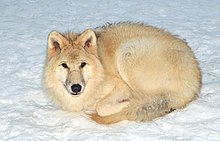Arctic wolf: Difference between revisions
{{Redirect|White Wolf}} |
m RHaworth moved page Arctic Wolf to Arctic wolf |
(No difference)
| |
Revision as of 19:49, 6 June 2012
| Arctic Wolf | |
|---|---|

| |
| Scientific classification | |
| Kingdom: | |
| Phylum: | |
| Class: | |
| Order: | |
| Family: | |
| Genus: | |
| Species: | |
| Subspecies: | C. l. arctos
|
| Trinomial name | |
| Canis lupus arctos Pocock, 1935
| |

| |
| Arctic Wolf ranges | |
The Arctic Wolf (Canis lupus arctos), also called Polar Wolf or White Wolf, is a subspecies of the Gray Wolf, a mammal of the family Canidae. Arctic Wolves inhabit the Canadian Arctic, Alaska and the northern parts of Greenland.
Anatomy
See also: Gray Wolf behavior and physiology
Habitat and distribution
The Arctic Wolf inhabits the Canadian Arctic and the islands, parts of Alaska and northern part of Greenland. Their habitat extends from 70° North latitude and higher. They have lived in North America for more than two million years.[citation needed] When they find a den, they make a couple of chambers for food and young. The Arctic Wolf is the only subspecies of the Gray Wolf that still can be found over the whole of its original range, largely because, in their natural habitat, they rarely encounter humans.The Arctic wolf is also the only subspecies of wolf which is not threatened - their remote home means that they are relatively safe from man's activities, both in terms of hunting and habitat destruction.
Their habitat is extremely harsh and remote, and few scientists venture into that world during the long, dark winter – even the vast majority of Inuit live further south than the Arctic wolf. As a result, the details of their lives through much of the year are virtually unknown.
Behavior
The Arctic Wolf can withstand the arctic weather, with the help in their thoroughly insulated fur. They can survive in sub-zero temperatures for years, in absolute darkness for five months per year, and without food for weeks. Arctic Wolves usually travel in packs of 2 to 20. They live in small family groups: a breeding pair (alpha male and female) and their pups. The pack works together to feed and care for their pups. Lone Arctic Wolves are young males that have left their pack to seek their own territories. They avoid other wolves, unless they are able to mate. Having found an abandoned territory, a lone Arctic Wolf will claim it by marking the territory with its scent, then gather other lone wolves into its pack. When the female is pregnant, she leaves the pack to dig a den to raise her pups. If the ice is too thick, she will move to a den or cave.
Hunting
Like all wolves, Arctic Wolves hunt in packs, preying mainly on caribou and muskoxen, but also arctic hares, seals, ptarmigan, lemmings, and smaller animals such as waterfowl.[1]. Due to the scarcity of prey, they roam large areas, up to 2,600 km2 (1,000 sq mi), and follow migrating caribou south during the winter, for a food source. They are not fast runners, instead relying on stamina to take down prey.[2]
Adult wolves have 42 teeth, their main weapon in hunting. They swallow food in large chunks, barely chewing it. They eat all of their prey, including the bones. Wolves can eat up to 20 pounds (9 kg) of meat at one meal. When they return from the hunt, wolves regurgitate some of the food for the hungry pups.[3]
Reproduction

Due to the Arctic's permafrost soil and the difficulty it always poses for digging dens, Arctic Wolves often use rock outcroppings, caves or even shallow depressions as dens instead. After gestation of about 63 days to 75 days, birth is in late May to early June, about a month later than Gray Wolves. The mother gives birth to 2 or 3 pups, though there may be as many as 12. This is fewer pups than Gray Wolves, which have four to five. It is generally thought that the lower number is due to the scarcity of prey in the Arctic. Pups are born blind and deaf, and weigh about one pound. They are dependent on their mother for food and protection. When they are 5 weeks old, they are allowed outside the den. Other wolves in the pack may take care of the mother’s pups until she returns with food.[4]
References
- L. David Mech (text), Jim Brandenburg (photos), At home with the Arctic wolf, National Geographic Vol. 171 No. 5 (May 1987), pp. 562–593
- L. David Mech, The Arctic wolf: 10 years with the pack, Voyageur Press 1997, ISBN 0-89658-353-8
Notes
- ^ Morelle, Rebecca (2009-01-31). "Elusive wolves caught on camera". BBC. Retrieved 2008-01-31.
- ^ Wolf traits
- ^ Arctic Wolf
- ^ Wolf facts
External links
- L. David Mech: Arctic Wolves and Their Prey
- White Wolf Sanctuary website
- Wolf survival website
- International Wolf Center – Arctic Wolf Information
- Tracking arctic wolves throughout the winter with a satellite collar
- National Geographic News Watch: Would Real Wolves Act Like the Wolves of ‘The Grey’?
